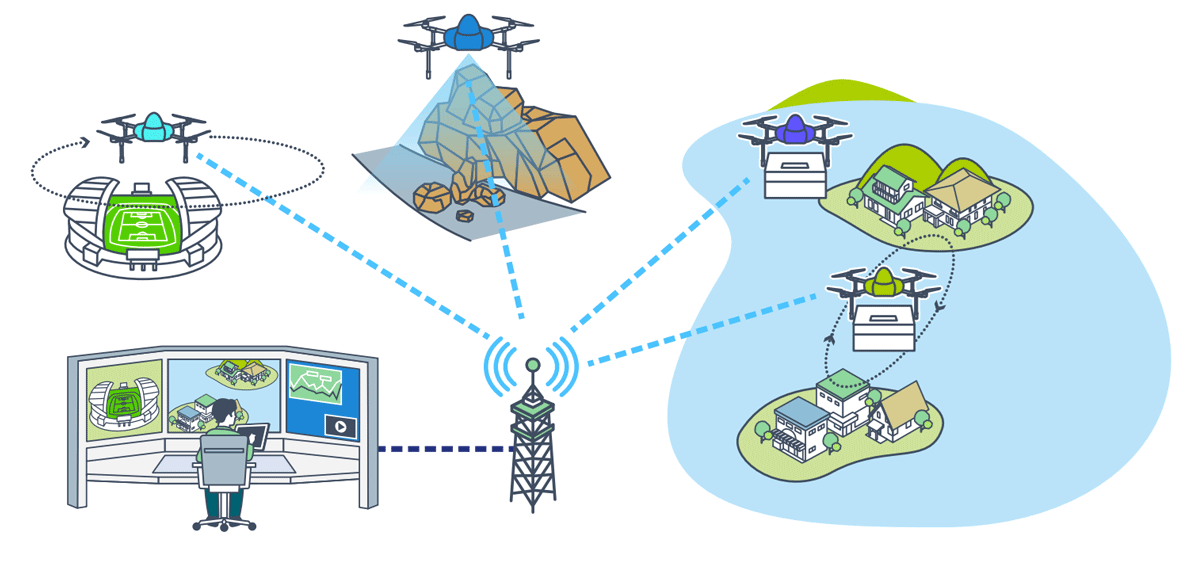- KDDI HOME
- Corporate Information
- News Releases
- 2022
- KDDI and JAL to launch Initiative to Realize One-to-Many Drone Operation
KDDI and JAL to launch Initiative to Realize One-to-Many Drone Operation
―Aiming for Operational Efficiency with an Eye toward Drone Level4 Operation―
- KDDI CORPORATION
- Japan Airlines Co., Ltd.
August 26,2022
KDDI CORPORATION (Headquarter: Chiyoda-ku, Tokyo President and CEO: Makoto Takahashi, hereinafter KDDI) and Japan Airlines Co., Ltd. (Headquarters: Shinagawa-ku, Tokyo, President: Yuji Akasaka, hereinafter JAL) are collaborating on the development of technologies to realize "one-to-many drone operation," in which a single operator operates multiple drones, with the goal of turning drones a social infrastructure. (hereinafter This Initiative)
This Initiative was proposed by KDDI and JAL as a project for the "Development of Elemental Technologies for Aircraft and Systems to Realize One-to-Many Drone Operations" under "Realization of Advanced Air Mobility Project: ReAMo Project" by New Energy and Industrial Technology Development Organization (hereinafter NEDO), and was selected on August 9, 2022.
With the lifting of the ban on "Beyond Visual Line of Sight (BVLOS) flight (Level 4 Operation)", which is scheduled to go into effect in December 2022, drones are expected to be used as a new aerial infrastructure by companies and local governments in various fields such as logistics, inspection, and disaster response.
KDDI and JAL formed a collaborative alliance in February 2022 [![]() 1] and have been working together to establish systems for integrated flight management of multiple drones and to examine business models for supporting the use of drones by companies and municipalities. This Initiative is aimed at realizing a "One-to-Many Drone Operation" in response to issues such as labor shortages and operational efficiency in drone operations.
1] and have been working together to establish systems for integrated flight management of multiple drones and to examine business models for supporting the use of drones by companies and municipalities. This Initiative is aimed at realizing a "One-to-Many Drone Operation" in response to issues such as labor shortages and operational efficiency in drone operations.

<Image of "One-to-Many Drone Operation">
In this Initiative, we will develop a flight control system that realizes "One-to-Many Drone Operation" by combining JAL's expertise in the operations, technologies and knowledge of the air transport business, including safety management and flight control, with the flight control system that enables remote control and autonomous flight of drones, which is being jointly developed by KDDI and KDDI SmartDrone Inc. (Head Office: Minato-ku, Tokyo President: Masafumi Hirono) [![]() 2].
2].
In the future, KDDI and JAL will continue to collaborate on the development of social infrastructure for drones, including this initiative, with the aim of creating a prosperous and sustainable society.
Please refer to the attached sheet for details.
■About this Initiative
1. Implementation Overview
KDDI and JAL jointly carry out the following:
- Consideration of systems and operational requirements for multiple drone flights
- Development of Flight Control System for "One-to-Many Operation"
- Obtaining approval for flight demonstrations
- Demonstration of simultaneous flights of multiple drones in multiple airspaces
- Business verification of "one-to-many drone operation"
2. About flight demonstration
In logistics and security use cases, we plan to conduct flight demonstrations for multiple simultaneous drone flights in multiple airspaces.
3. Role
KDDI
- Consideration of system requirements
- Operation management system development
- Demonstration of security use cases and business verification
JAL
- Safety Assessment Method, Review of Operation Requirements
- Development of safety assessment technology
- Logistics use case demonstration and business verification
(Reference)
■KDDI and JAL Alliance
KDDI and JAL have accumulated knowledge and experience for the automatic and autonomous operation of drones, as well as for the high-density and high-frequency operation of drones, through the simultaneous demonstration of multiple drones [![]() 3], the delivery of pharmaceuticals in Hyogo Prefecture [
3], the delivery of pharmaceuticals in Hyogo Prefecture [![]() 4], and the first demonstration of drones crossing multiple Ohashi bridges in Tokyo [
4], and the first demonstration of drones crossing multiple Ohashi bridges in Tokyo [![]() 5]. We will continue to conduct flight demonstrations and aim to further promote the social implementation of drones in Japan.
5]. We will continue to conduct flight demonstrations and aim to further promote the social implementation of drones in Japan.
■NEDO's Realization of Advanced Air Mobility Project (ReAMo Project)
With the need for operational efficiency due to labor shortages and increased logistics volume, as well as contactless services under the pandemic, next-generation air mobility (drones and flying cars) is expected to provide free movement of people and goods with energy savings and less manpower. To realize this goal, it is necessary to build efficient automated and autonomous operations on the premise of ensuring the safety of next-generation air mobility.
This project will develop performance evaluation methods for drones and flying vehicles, and integrate drones, flying vehicles, and existing aircraft that coexist in low-altitude airspace.
Through the development of flight management technology and other technologies necessary to realize next-generation air mobility, we will realize energy conservation and safe and efficient air transportation.
